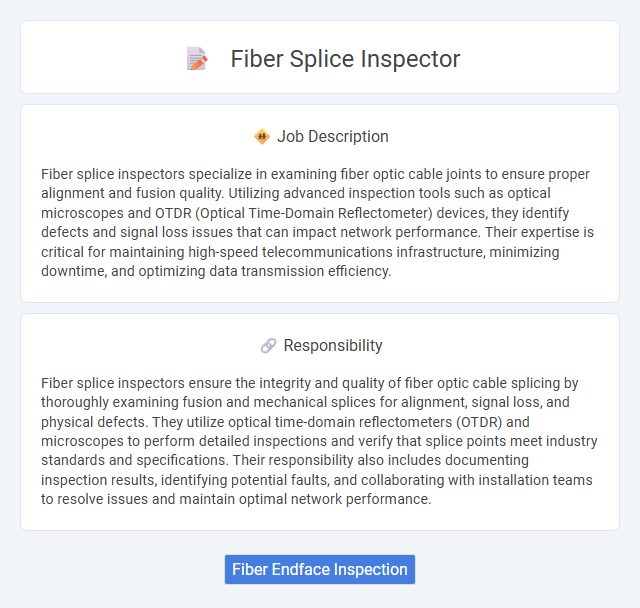
Fiber splice inspectors specialize in examining fiber optic cable joints to ensure proper alignment and fusion quality. Utilizing advanced inspection tools such as optical microscopes and OTDR (Optical Time-Domain Reflectometer) devices, they identify defects and signal loss issues that can impact network performance. Their expertise is critical for maintaining high-speed telecommunications infrastructure, minimizing downtime, and optimizing data transmission efficiency.
Individuals with strong attention to detail and good manual dexterity are likely suitable for a fiber splice inspector role, as the job requires precise handling of delicate fiber optic cables. Those who are comfortable working in confined spaces and have patience to perform repetitive tasks may find themselves well-suited for the position. Candidates with a background in telecommunications or electronics might have a higher probability of success compared to those without prior technical experience.
Qualification
A Fiber Splice Inspector must possess expertise in fiber optic technology, including proficiency with fusion splicing equipment and optical time-domain reflectometers (OTDR). Certification from recognized bodies such as BICSI, ETA International, or Fiber Optic Association (FOA) enhances qualification credibility. Strong understanding of fiber optic cable standards, meticulous attention to splice quality, and the ability to analyze test results to ensure minimal signal loss are essential for this role.
Responsibility
Fiber splice inspectors ensure the integrity and quality of fiber optic cable splicing by thoroughly examining fusion and mechanical splices for alignment, signal loss, and physical defects. They utilize optical time-domain reflectometers (OTDR) and microscopes to perform detailed inspections and verify that splice points meet industry standards and specifications. Their responsibility also includes documenting inspection results, identifying potential faults, and collaborating with installation teams to resolve issues and maintain optimal network performance.
Benefit
Fiber splice inspector jobs likely offer benefits including competitive salaries and opportunities for career advancement in the telecommunications industry. The role may provide skill development in fiber optic technology, which can increase employability and market value. Benefits might also include working in dynamic environments where problem-solving skills are regularly enhanced.
Challenge
Fiber splice inspector roles likely involve complex challenges related to ensuring precise alignment and quality of fiber optic connections. Inspectors probably face difficulties in identifying microscopic defects or misalignments that could affect network performance. The job may demand meticulous attention to detail and proficiency with advanced diagnostic tools to maintain optimal fiber optic integrity.
Career Advancement
Fiber splice inspectors play a crucial role in ensuring the integrity and quality of optical fiber connections by meticulously examining splices for losses or faults. Career advancement opportunities often lead to senior technical roles, project management positions, or specialized training in advanced fiber optic technologies, enhancing both expertise and leadership skills. Pursuing certifications such as Certified Fiber Optic Technician (CFOT) can significantly boost prospects for higher salaries and managerial responsibilities.
Key Terms
Fiber Endface Inspection
Fiber splice inspectors specialize in examining fiber optic endfaces to ensure optimal signal transmission and minimize insertion loss. Using advanced microscopes and inspection software, they identify contaminants, scratches, or defects on fiber endfaces that could degrade network performance. Their precise evaluation and cleaning recommendations are critical for maintaining high-quality splices in telecommunications and data networks.
 kuljobs.com
kuljobs.com